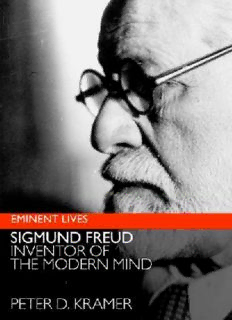
Freud: Inventor of the Modern Mind PDF
Preview Freud: Inventor of the Modern Mind
F r e u d Inventor of the Modern Mind Peter D. Kramer e m i n e n t l i v e s For my teachers, for my patients, and, as always, for Rachel Eminent Lives, a series of brief biographies by distinguished authors on canonical figures, joins a long tradition in this lively form, from Plutarch’s Lives to Vasari’s Lives of the Painters, Dr. Johnson’s Lives of the Poets to Lytton Strachey’s Eminent Victo- rians. Pairing great subjects with writers known for their strong sensibilities and sharp, lively points of view, the Eminent Lives are ideal introductions designed to appeal to the general reader, the student, and the scholar. “To preserve a becoming brevity which excludes everything that is redundant and nothing that is significant,” wrote Strachey: “That, surely, is the fi rst duty of the biographer.” Contents Chapter One Climate of Opinion 1 Chapter Two Development of the Hero 17 Chapter h ree Steps and Stumbles 28 Chapter Four The Problem of Psychology 44 Chapter Five Seduction 61 Chapter Six Dreams 82 Chapter Seven Consolidation 98 Chapter Eight Agenbite 115 Chapter Nine New World 127 Chapter Ten Frie nd and Foe 142 Chapter Eleven Structure 159 Chapter Twelve C ulture 176 Chapter h irteen Limitations 185 Chapter Fourteen Final Things 192 Chapter Fifteen Loss 200 Bibliographic Note 212 About the Author Other Books by Peter D. Kramer Other Books in the Eminent Lives Series Credits Cover Copyright About the Publisher v Chapter One Climate of Opinion I n 1922, a distraught husband framed a challenge for Sigmund Freud: “Great Doctor, are you savant or charla- tan?” Though he had interviewed her only briefly, Freud had advised the man’s wife to leave him and marry her former analyst, a patient and protégé of Freud’s. The injured party, Abraham Bijur, was a person of means. He intended to make his grievance public in the New York Times. But Bijur died just after the letter was composed. Nearly seven decades would pass before its contents were shared with the Times’s readers. For most of those years, Freud was very much Bijur’s “savant”—a towering intellectual figure. He was, to begin with, the greatest psychiatrist of the age. He appeared to pos- sess special powers of observation that allowed him to turn his work with patients into innovative science. Using methods he had himself developed, Freud had discovered and mapped the unconscious. He had named the components of the mind and 11 Peter D. Kramer explored the principles by which they operated. He had charted the sequence of human psychological growth, from infancy to mature adulthood. He had identified the causes of most mental illnesses and invented a method for treating them. Freud was more than the parfit physician. He was also a wise man, whose account of the diseased mind had profound implications for our understanding of the human condition. Beneath apparent rationality, Freud had discerned dark im- pulses and contradictory yearnings that coalesced into predict- able patterns he called complexes. He had demonstrated that, in the culture and in the lives of individuals, hidden symbols abound; our customs and behaviors simultaneously hide and reveal sexual and aggressive drives incompatible with the re- quirements of civilized society. Freud’s theories seemed to update ancient philosophies, casting our lives as tragic dramas of a distinctively modern sort. It was as if, before Freud, we had never known ourselves. Then, a quarter of a century ago, Freud’s status began to change. Forgotten documents came to light. They showed that Freud had regularly misrepresented the development of his ideas and the details of his own life story. The new un- derstanding of Freud’s clinical work was particularly troubling. He had altered fact to fit theory, conducted therapies in ways that bore scant relationship to his precepts, and claimed suc- cess in treatments that had failed. How damaging were these fi ndings, in light of Freud’s contributions? The answer to that question might depend in part on the status of Freud’s ideas, which were themselves falling from favor. Freud’s supporters 2 FREUD and his detractors took opposing positions, in the controversy known as “the Freud Wars.” Bijur’s challenge moved to center stage: savant or charlatan? The case that so pained Abraham Bijur contributed to the reas- sessment. Bijur, a financier, was married to a younger woman, Angelika, who was wealthy in her own right. Angelika Bijur had entered into a sexual relationship with her former analyst, the prominent American psychiatrist Horace Frink. Frink was married, with two young children. He had long been prone to mood disorder, and in the course of the affair, he became emotionally disturbed. Uncertain how to proceed, Frink traveled to Vienna at Angelika Bijur’s expense to under- take a course of analysis with Freud. Frink had a difficult history. When he was eight, his father suffered a business failure. The father moved in search of work, taking his wife with him and leaving Frink in the care of grandparents. When Frink was fifteen, his mother died of tuberculosis. In his mid-twenties, Frink succumbed to depres- sion. Despite psychoanalytic treatment, he became depressed again in his thirties. Frink understood himself to be subject to mood swings. In 1921, at age thirty-eight, Frink consulted Freud. Frink was in an agitated, sometimes euphoric state. He was waking at three in the morning. He described himself as “more talkative and full of fun than ever before in my life,” though he also ex- perienced a “sense of unreality.” In retrospect—and in the eyes of the doctor who took over after Freud withdrew from the 3
Description: